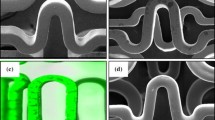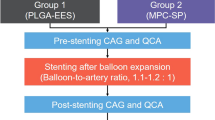Abstract
Drug eluting stents (DES) have become a common mode of treatment for stenosis in coronary arteries. However, currently, the use of sirolimus/paclitaxel-coated DES has come under scrutiny, because of their pro-thrombotic effects leading to potential adverse outcomes in the long run. We have previously documented that d-threo-1-phenyl-2-decanoylamino-3-morholino propanol (D-PDMP); an inhibitor of glucosylceramide synthase and lactosylceramide (LacCer) synthase markedly inhibited platelet-derived growth factor (PDGF)-induced cell proliferation. We have fabricated DES wherein, D-PDMP or sirolimus was coated on to a double layer of poly (lactic-co-glycolic acid) on a bare metal stent. The in vitro release of D-PDMP from biopolymer and its consequent effect on PDGF induced proliferation and apoptosis was assessed in human aortic smooth muscle cells (ASMC). D-PDMP was released from biopolymers in a dose-dependent fashion and was accompanied with a decrease in PDGF-induced cell proliferation, but not apoptosis. In contrast, sirolimus markedly increased apoptosis in these cells in addition to inhibiting proliferation. Our mechanistic studies revealed that D-PDMP, but not sirolimus decreased the cellular level of glucosyl and lactosylceramide that accompanied inhibition of PDGF-induced cell proliferation. Our short-term (14 days) in vivo studies in rabbits also attested to the safety and biocompatibility of the D-PDMP coated stents. Our data reveal the superiority of D-PDMP coated biopolymers over sirolimus coated biopolymers in mitigating ASMC proliferation. Such D-PDMP coated stents may be useful for localized delivery of drug to mitigate neo-vascular hyperplasia and other proliferative disorders.






Similar content being viewed by others
Abbreviations
- DPDMP:
-
d-threo-1-phenyl-2-decanoylamino-3-morholino propanol
- PDGF:
-
platelet-derived growth factor
- LacCer:
-
lactosylceramide
- GLcCer:
-
glucosylceramide
- HPLC:
-
high performance liquid chromatography
- PLGA:
-
polylactic-co-glycolic acid
- TNF:
-
tissue necrosis factor
- ASMC:
-
aortic smooth muscle cells
- DES:
-
drug eluting stents
References
AHA/ACC Clinical Performance Measures, Chronic Stable Coronary Artery Disease (2003)
Anis, R.R., Karsch, K.R., Oberhoff, M.: An update on clinical and pharmacological aspects of drug-eluting stents. Cardiovasc. Hematol. Disord. Drug Targets 6, 245–255 (2006)
Serruys, P.W., de Jaegere, P., Kiemeneij, F., Macaya, C., Rutsch, W., Heyndrickx, G., et al.: A comparison of balloon-expandable-stent implantation with balloon angioplasty in patients with coronary artery disease. N. Engl. J. Med. 331, 489–495 (1994). doi:10.1056/NEJM199408253310801
Fischman, D.L., Leon, M.B., Baim, D.S., Schatz, R.A., Savage, M.P., Penn, I., et al.: A randomized comparison of coronary-stent placement and balloon angioplasty in the treatment of coronary artery disease. N. Engl. J. Med. 331, 496–501 (1994). doi:10.1056/NEJM199408253310802
Holmes, D.R., Vliestra, R.E., Smith, H.C., Vetrovec, G.W., Kent, K.M., Cowley, M.J., et al.: Restenosis after percutaneous transluminal coronary angioplasty (PTCA), a report from the PTCA Registry of the National Heart, Lung, and Blood Institute. Am. J. Cardiol. 53, 77C–81C (1984). doi:10.1016/0002-9149(84)90752-5
Ong, A.T., McFadden, E.P., Regar, E., de Jaegere, P.P., van Domburg, R.T., Serruys, P.W.: Late angiographic stent thrombosis (LAST) events with drug-eluting stents. J. Am. Coll. Cardiol. 45, 2088–2092 (2005). doi:10.1016/j.jacc.2005.02.086
Pfisterer, M., Brunner-La Rocca, H.B., Buser, P.T., Rickenbacher, P., Hunziker, P., Mueller, C., et al.: BASKET-LATE investigators. Late clinical events after clopidogrel discontinuation may limit the benefit of drug-eluting stents, an observational study of drug-eluting stents versus bare-metal stents. J. Am. Coll. Cardiol. 48, 2584–2591 (2006). doi:10.1016/j.jacc.2006.10.026
Nordmann, A.J., Briel, M., Bucher, H.C.: Mortality in randomized controlled trials comparing drug-eluting vs. bare metal stents in coronary artery disease, a meta-analysis. Eur. Heart J. 27, 2784–2814 (2006). doi:10.1093/eurheartj/ehl282
Camenzind, E., Steg, G., Wijns, W.: Safety of drug-eluting stents, a meta-analysis of 1st generation DES programs. Presented at the European Society of Cardiology 2006 World Congress, Barcelona, September 2–6 (2006)
Luscher, T.F., Steffel, J., Eberli, F.R., Joner, M., Nakazawa, G., Tanner, F.C., et al.: Drug-eluting stent and coronary thrombosis, biological mechanisms and clinical implications. Circulation 115, 1051–1058 (2007). doi:10.1161/CIRCULATIONAHA.106.675934
Stone, G.W., Moses, J.W., Ellis, S.G., Schofer, J., Dawkins, K.D., Morice, M.C., et al.: Safety and efficacy of sirolimus- and paclitaxel-eluting coronary stents. N. Engl. J. Med. 356, 998–1008 (2007). doi:10.1056/NEJMoa067193
Maisel, W.H.: Unanswered questions-drug-eluting stents and the risk of late thrombosis. N. Engl. J. Med. 356, 981–984 (2007). doi:10.1056/NEJMp068305
Shuchman, M.: Trading restenosis for thrombosis? New questions about drug-eluting stents. N. Engl. J. Med. 355, 1949–1952 (2006). doi:10.1056/NEJMp068234
Groeneveld, P.W., Suh, J.J., Matta, M.A.: The costs and quality-of-life outcomes of drug-eluting coronary stents a, systematic review. J. Interv. Cardiol. 20, 1–9 (2007). doi:10.1111/j.1540-8183.2007.00214.x
Katritsis, D.G., Karvouni, E., Ioannidis, J.P.: Meta-analysis comparing drug-eluting stents with bare metal stents. Am. J. Cardiol. 95, 640–643 (2005). doi:10.1016/j.amjcard.2004.10.041
Slavin, L., Chhabra, A., Tobis, J.M.: Drug-eluting stents, preventing restenosis. Cardiol. Rev. 15, 1–12 (2007). doi:10.1097/01.crd.0000200844.16899.fc
Mintz, G.S., Popma, J.J., Pichard, A.D., Kent, K.M., Satler, L.F., Wong, C., et al.: Arterial remodeling after coronary angioplasty, a serial intravascular ultrasound study. Circulation 94, 35–43 (1996)
Hoffmann, R., Mintz, G.S., Dussaillant, G.R., Popma, J.J., Pichard, A.D., Satler, L.F., et al.: Patterns and mechanisms of in-stent restenosis. A serial intravascular ultrasound study. Circulation 94, 1247–1254 (1996)
Kornowski, R., Hong, M.K., Tio, F.O., Bramwell, O., Wu, H., Leon, M.B.: In-stent restenosis, contributions of inflammatory responses and arterial injury to neointimal hyperplasia. J. Am. Coll. Cardiol. 31, 224–230 (1998). doi:10.1016/S0735-1097(97)00450-6
Curfman, G.D.: Sirolimus eluting coronary stents. N. Engl. J. Med. 346, 1770–1771 (2002). doi:10.1056/NEJM200206063462302
De Scheerder, I.K., Wilczek, K.L., Verbeken, E.V., Vandorpe, J., Lan, P.N., Schacht, E., et al.: Biocompatibility of polymer-coated oversized metallic stents implanted in normal porcine coronary arteries. Atherosclerosis 114, 105–114 (1995). doi:10.1016/0021-9150(94)05472-U
Rechavia, E., Litvack, F., Fishbien, M.C., Nakamura, M., Eigler, N.: Biocompatibility of polyurethane-coated stents, tissue and vascular aspects. Cathet. Cardiovasc. Diagn. 45, 202–207 (1998). doi:10.1002/(SICI)1097-0304(199810)45:2<202::AID-CCD20>3.0.CO;2-L
Van der Giessen, W.J., Lincoff, A.M., Schwartz, R.S., van Beusekom, H.M., Serruys, P.W., Holmes Jr., D.R., et al.: Marked inflammatory sequelae to implantation of biodegradable and nonbiodegradable polymers in porcine coronary arteries. Circulation 94, 1690–1697 (1996)
Venkatraman, S., Boey, F.Y.C.: Release profiles in drug-eluting stents, issues and uncertainties. J. Control. Release 120, 149–160 (2007). doi:10.1016/j.jconrel.2007.04.022
Ranade, S.V., Miller, K.M., Richard, R.E.: Physical characterization of controlled release of paclitaxel from the TAXUS™ Express2™ drug-eluting stent. J. Biomed. Mater. Res. A 71, 625–634 (2004). doi:10.1002/jbm.a.30188
Finn, A.V., Kolodgie, F.D., Harnek, J., Guerrero, L.J., Acampado, E., Tefera, K., et al.: Differential response of delayed healing and persistent inflammation at sites of overlapping sirolimus- or paclitaxel-eluting stents. Circulation 112, 270–278 (2005). doi:10.1161/CIRCULATIONAHA.104.508937
Joner, M., Finn, A.V., Farb, A., Mont, E.K., Kolodgie, F.D., Ladich, E., et al.: Pathology of drug-eluting stents in humans, delayed healing and late thrombotic risk. J. Am. Coll. Cardiol. 48, 193–202 (2006). doi:10.1016/j.jacc.2006.03.042
Ross, R.: The pathogenesis of atherosclerosis, a perspective for the1990s. Nature 363, 801–809 (1993). doi:10.1038/362801a0
Libby, P., Ridker, P.M., Maseri, A.: Inflammation and atherosclerosis. Circulation 105, 1135–1143 (2002). doi:10.1161/hc0902.104353
Bhunia, A.K., Arai, T., Bulkley, G., Chatterjee, S.: Lactosylceramide mediates tumor necrosis factor-α-induced intercellular adhesion molecule-1 (ICAM-1) expression and the adhesion of neutrophil in human umbilical vein endothelial cells. J. Biol. Chem. 273(51), 34349–34357 (1998). doi:10.1074/jbc.273.51.34349
Arai, T., Bhunia, A.K., Chatterjee, S., Bulkley, G.B.: Lactosylceramide stimulates human neutrophils to upregulate Mac-1, adhere to endothelium, and generate reactive oxygen metabolites in vitro. Circ. Res. 82, 540–547 (1998)
Rajesh, M., Kolmakova, A., Chatterjee, S.: Novel role of lactosylceramide in vascular endothelial growth factor mediated angiogenesis in human endothelial cells. Circ. Res. 97(8), 796–804 (2005). doi:10.1161/01.RES.0000185327.45463.A8
Kolmakova, A., Chatterjee, S.: Platelet derived growth factor recruits lactosylceramide to induce cell proliferation in UDP Gal,GlcCer, β1→4Galactosyltransferase (GalT-V) mutant Chinese hamster ovary cells. Glycoconj. J. 22, 401–407 (2005). doi:10.1007/s10719-005-3351-1
Chatterjee, S.: Lactosylceramide stimulates aortic smooth muscle cell proliferation. Biochem. Biophys. Res. Commun. 181, 554–561 (1991). doi:10.1016/0006-291X(91)91225-2
Bhunia, A.K., Han, H., Snowden, A., Chatterjee, S.: Lactosylceramide stimulates Ras-GTP loading, kinases (MEK, Raf), p44 mitogen-activated protein kinase, and c-fos expression in human aortic smooth muscle cells. J. Biol. Chem. 271, 10660–10666 (1996). doi:10.1074/jbc.271.18.10660
Bhunia, A.K., Han, H., Snowden, A., Chatterjee, S.: Redox-regulated signaling by lactosylceramide in the proliferation of human aortic smooth muscle cells. J. Biol. Chem. 272, 15642–15649 (1997). doi:10.1074/jbc.272.25.15642
Chatterjee, S.: Oxidized low density lipoproteins and lactosylceramide both stimulate the expression of proliferating cell nuclear antigen and the proliferation of aortic smooth muscle cells. Indian J. Biochem. Biophys. 34, 56–60 (1997)
Chatterjee, S., Bhunia, A.K., Snowden, A., Han, H.: Oxidized low density lipoproteins stimulate galactosyltransferase activity, ras activation, p44 mitogen activated protein kinase and c-fos expression in aortic smooth muscle cells. Glycobiology 7, 703–710 (1997). doi:10.1093/glycob/7.5.703
Chatterjee, S.: Sphingolipids in atherosclerosis and vascular biology. Arterioscler. Thromb. Vasc. Biol. 18, 1523–1533 (1998)
Chatterjee, S.: Assay of lactosylceramide synthase and comments on its potential role in signal transduction. Methods Enzymol. 311, 73–81 (2000). doi:10.1016/S0076-6879(00)11068-7
Gombotz, W.R., Pettit, D.K.: Biodegradable polymers for protein and peptide drug delivery. Bioconjug. Chem. 6, 332–351 (1995). doi:10.1021/bc00034a002
Leenslag, J.W., Pennings, A.J., Bos, R.R., Rozema, F.R., Boering, G.: Resorbable materials of poly(l-lactide). Biomaterials 8, 70–73 (1987). doi:10.1016/0142-9612(87)90034-2
Jurgens, C.H., Kricheldorf, H.R., Kreiser-Saunders, I.: Development of a biodegradable wound covering and first clinical results. In: Walenkamp, G.H.I.M. (ed.) Biomaterials in Surgery, pp. 112–120. Thieme, New York (1998)
Hubbell, J.A.: Biomaterials in tissue engineering. Biotechnology 13, 565–576 (1995). doi:10.1038/nbt0695-565
Pan, C.J., Tang, J.J., Weng, Y.J., Wang, J., Huang, N.: Preparation, characterization and anticoagulation of curcumin-eluting controlled biodegradable coating stents. J. Control. Release 116, 42–49 (2006). doi:10.1016/j.jconrel.2006.08.023
Sternberg, K., Kramer, S., Nischan, C., Grabow, N., Langer, T., Hennighausen, G., et al.: In vitro study of drug-eluting stent coatings based on poly(L-lactide) incorporating cyclosporine A—drug release, polymer degradation and mechanical integrity. J. Mater. Sci. Mater. Med. 18, 1423–1432 (2007). doi:10.1007/s10856-007-0148-8
Pasterkamp, G., de Kleijn, D.P., Borst, C.: Arterial remodeling in atherosclerosis, restenosis and after alteration of blood flow, potential mechanisms and clinical implications. Cardiovasc. Res. 45, 843–852 (2000). doi:10.1016/S0008-6363(99)00377-6
Welt, F.G., Rogers, C.: Inflammation and restenosis in the stent era. Arterioscler. Thromb. Vasc. Biol. 22, 1769–1776 (2002). doi:10.1161/01.ATV.0000037100.44766.5B
Fingar, D.C., Blenis, J.: Target of rapamycin (TOR), an integrator of nutrient and growth factor signals and coordinator of cell growth and cell cycle progression. Oncogene 23, 3151–3371 (2004). doi:10.1038/sj.onc.1207542
Jefferies, H.B., Thomas, G., Thomas, G.: Elongation factor-1 α mRNA is selectively translated following mitogenic stimulation. J. Biol. Chem. 269, 4367–4372 (1994)
Gingras, A.C., Raught, B., Sonenberg, N.: mTOR signaling to translation. Curr. Top. Microbiol. Immunol. 279, 169–197 (2004)
Gingras, A.C., Raught, B., Sonenberg, N.: eIF4 initiation factors, effectors of mRNA recruitment to ribosomes and regulators of translation. Annu. Rev. Biochem. 68, 913–963 (1999). doi:10.1146/annurev.biochem.68.1.913
Braun-Dullaeus, R.C., Mann, M.J., Seay, U., Zhang, L., von Der Leyen, H.E., Morris, R.E., et al.: Cell cycle protein expression in vascular smooth muscle cells in vitro and in vivo is regulated through phosphatidylinositol 3-kinase and mammalian target of rapamycin. Arterioscler. Thromb. Vasc. Biol. 7, 1152–1158 (2001). doi:10.1161/hq0701.092104
Marks, A.R.: Rapamycin, signaling in vascular smooth muscle. Transplant. Proc. 35(suppl 3), 231S–233S (2003). doi:10.1016/S0041-1345(03)00243-4
Marks, A.R.: Sirolimus in prevention of in-stent restenosis in a coronary artery. N. Engl. J. Med. 349, 1307–1309 (2003). doi:10.1056/NEJMp038141
Schachner, T., Oberhuber, A., Zou, Y., Tzankov, A., Ott, H., Laufer, G., et al.: Rapamycin treatment is associated with an increased apoptosis rate in experimental vein grafts. Eur. J. Cardiothorac. Surg. 27, 302–306 (2005). doi:10.1016/j.ejcts.2004.11.008
Giordano, A., Avellino, R., Ferraro, P., Romano, S., Corcione, N., Romano, M.F.: Rapamycin antagonises NF-kb nuclear translocation activated by TNF-a in primary vascular smooth muscle cells and enhances apoptosis. Am. J. Physiol. Heart Circ. Physiol. 290, H2459–H2465 (2006). doi:10.1152/ajpheart.00750.2005
Matter, C.M., Chadjichristos, C.E., Meier, P., von Lukowicz, T., Lohmann, C., Schuler, P.K., et al.: Role of endogenous FAS (CD95/Apo-1)ligand in balloon induced apoptosis, inflammation and neointimal formation. Circulation 113, 1879–1887 (2006). doi:10.1161/CIRCULATIONAHA.106.611731
Acknowledgements
We acknowledge Merlin Medical, Singapore for the assistance in the evaluation of crimped stents, as well as for the helpful discussions. This work was supported via funds from the Economic development board of Singapore, A*STAR and from the Johns Hopkins University, School of Medicine Institutional Funds.
Author information
Authors and Affiliations
Corresponding authors
Additional information
Yong-Dan Tang, Ambarish Pandey, Subbu S. Venkatraman, and Subroto Chatterjee contributed equally to this work.
Rights and permissions
About this article
Cite this article
Tang, YD., Pandey, A., Kolmakova, A. et al. Use of a novel anti-proliferative compound coated on a biopolymer to mitigate platelet-derived growth factor-induced proliferation in human aortic smooth muscle cells: comparison with sirolimus. Glycoconj J 26, 721–732 (2009). https://doi.org/10.1007/s10719-008-9192-y
Received:
Revised:
Accepted:
Published:
Issue Date:
DOI: https://doi.org/10.1007/s10719-008-9192-y




